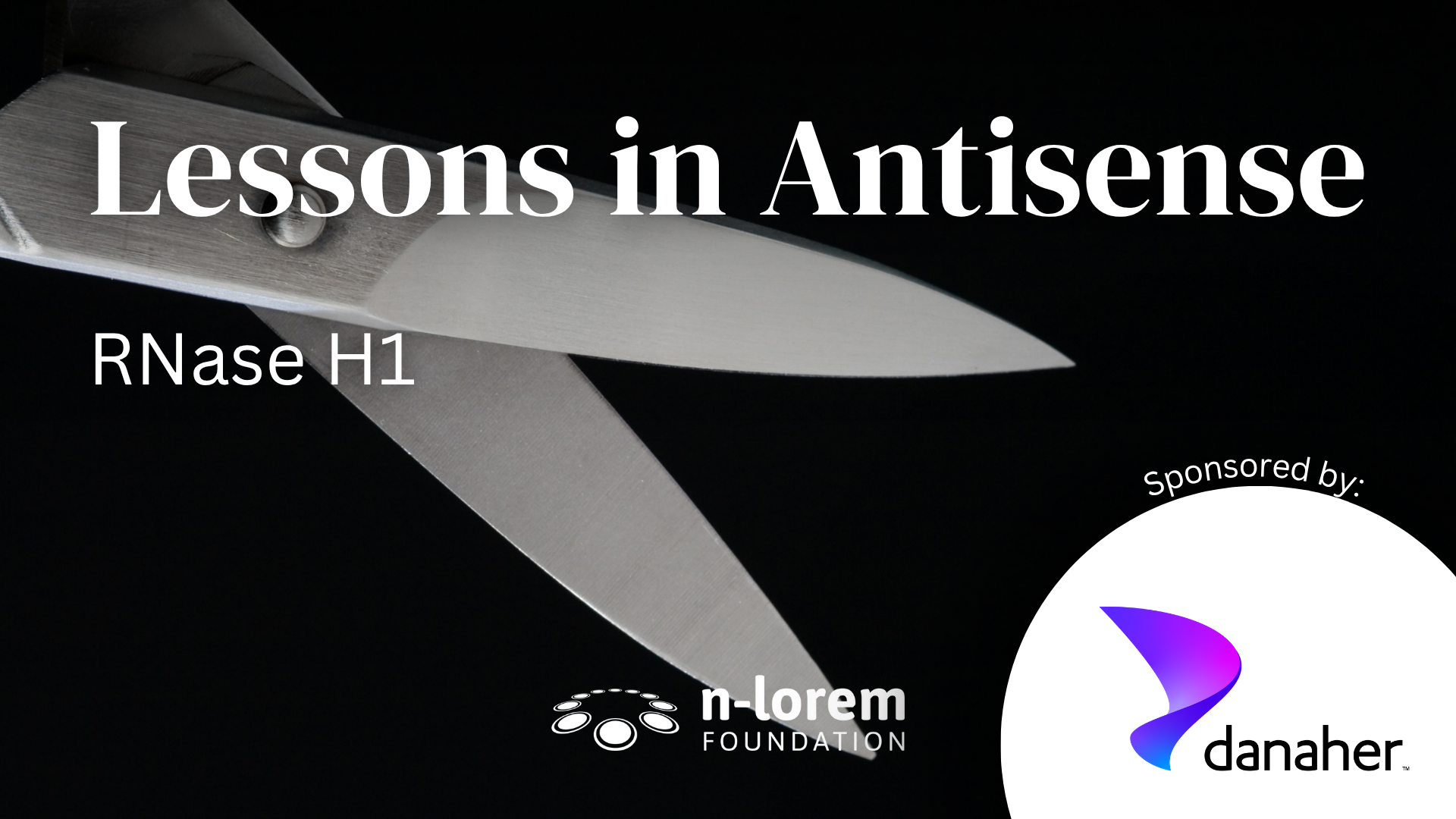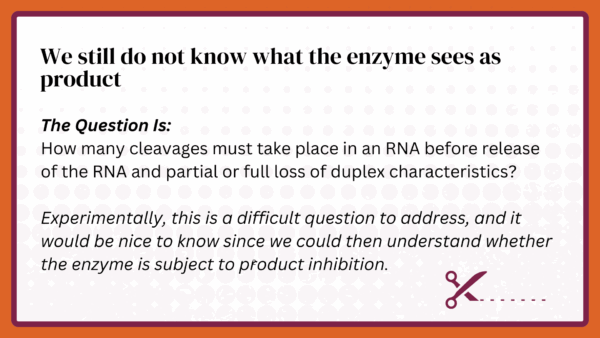Lessons in Antisense
Lesson 10 – RNase H1
June 23, 2025 by Dr. Stan Crooke

Introduction
RNases H, or ribonucleases H, are members of the nucleotidyl transferase family of endonucleases and cleave RNA via an in-line hydrolytic mechanism. Because the reaction proceeds through a 2’, 3’-cyclic intermediate, these enzymes produce 5’-phosphate, 3’-OH products. Though three canonical RNase H1s have been reported in mammalian cells, in the cells we have studied, only RNase H1 and RNase H2 have been expressed. Argonaute 2 is also an H type nuclease. RNase H2 is at least 20-fold more abundant than H1, but only H1 is involved in ASO activity. We believe that this is because H2 is chromatin associated. However, if one creates a cell homogenate, H2 is released from chromatin and will account for the cleavage rate and pattern of cleavage. H1 is active as a monomer while H2 has 3 subunits and is active only as a multimer.
H1 architecture
H1 is comprised of four domains: a mitochondrial leader sequence, a “hybrid” domain, a spacer domain, and a catalytic domain. H1 mRNA has two translation initiation sequences and an active upstream open reading frame (uORF). Though there is a mitochondrial leader sequence, most cellular H1 is translated from the second translation initiation site and does not contain the mitochondrial leader peptide. Though the N-terminal domain has been called a “hybrid binding”, we have shown that it has about the same affinity for any duplex.
The carboxy terminus is made of the catalytic domain, which is highly homologous to E. coli RNase H1. The catalytic center is made up of a histidine, a glutamic acid residue, and two aspartic acids. The enzymatic mechanism is magnesium-dependent, and the crystal structure shows two magnesium binding sites.
H1 roles
Though the total cellular concentration of H1 is low, it is present throughout the cell. Knocking out H1 is embryonically lethal, but we generated viable H1 knockout mice by use of an albumin promoter which is expressed late in gestation. We also made tamoxifen-inducible knockout mice. In viable knock-out animals, we saw significant increases in R-loops both in nuclear and mitochondrial DNA that disrupted transcription of ribosomal genes.
Mitochondrial dysfunction and altered fission/fusion were the first pathological observations followed by liver failure.
The levels of H1 are carefully regulated, and we have shown that H1 overexpression is acutely cytotoxic.
H1 substrate requirements
In a duplex, H1 requires a minimum of 4 deoxynucleotides to cleave the RNA strand. A 2’-methoxy in RNA blocks the cleavage as does a 2’ substituent on the DNA strand. Optimal activity is observed with a true DNA/RNA duplex. In fact, a gapmer design forms a duplex that is not optimal for H1 activity, and the enzymatic activity increases as the length of the DNA gap is increased. Despite the fact that gapmer-RNA duplexes are not optimal substrates for H1, 2-MOE gapmers provide a significant increase in ASO potency.
Importantly, phosphorothioate (PS) oligonucleotides can bind in the hybrid binding domain and the catalytic domain, which disrupts the H1 structure. PS oligonucleotides also are competitive inhibitors of the enzyme. For these reasons, in enzymatic assays, it is usually best to use a phosphodiester (PO) gapmer.
H1 has a pair of vicinal cysteines in the catalytic domain that are easily oxidized to form a disulfide. Consequently, it is important to keep the enzyme reduced. Manganese and magnesium can support enzymatic activity, and manganese actually results in a greater catalytic rate. We have also shown that H1 can cleave one to two nucleotides in a 3’-RNA overhang.
Both the total cleavage and the pattern of cleavage are influenced by the RNA sequence. We suspect that this is due to subtle differences in duplex geometry but have not proven that.
We have also shown that RNAs that have more than one cognate site for an ASO are cleaved more rapidly in cells and test tubes than those with a single ASO binding site. In fact, the rate of cleavage increases linearly with increasing numbers of ASO binding sites, and the sites act independently to increase cleavage rate. We believe that extra binding sites simply increase the fraction of binding events that are enzymatically productive.
H1 is minimally processive
Under single-hit conditions, we have shown that H1 can cleave a site and as many as two adjacent sites processively. However, under conditions more analogous to those in a cell, essentially all cleavage sites in an RNA represent a population of RNA molecules cleaved at different nucleotides, and some RNA molecules have more than one cleavage site secondary to release of the enzyme, re-binding, and cleavage.

Multiple RNA-binding proteins (RBPs) can compete with H1 for duplex binding
We have identified several RBPs that appear to either be more abundant or have greater affinity than H1 for a PS ASO/RNA duplex. Furthermore, in rapidly translated mRNAs, ribosomes can compete with H1, reducing cleavage rates.
H1 interactome
H1 has an extensive interactome that includes proteins like DDX21 and NAT10 that increase enzymatic activity.
Post-H1 cleavage metabolism of RNA
We have shown that after H1 cleaves and releases the substrate RNA, the RNA is further degraded by standard RNases. In the nucleus, the 5’-end exonucleolytic cleavage is effected by XRN2 and in the cytoplasm by XRN1. 3’ degradation is effected by the 3’-exonuclease complex. To answer some questions, we have found it convenient to inhibit further nuclease digestion, in effect trapping the H1 cleavage products.
The rate limiting step in the pharmacology of RNase H1 ASOs in cells is the recruitment of H1 to the heteroduplex.
RNase H1 is active in both the cytosol and the nucleus and if one adjusts for volume, H1 activity is approximately equal in the nucleus and cytosol.
Conclusions
PS ASO gapmers are the most broadly used ASOs, and the mechanism is robustly active in the nucleus and cytosol. We have shown that PS ASOs designed to create hetero-duplexes that are substrates for RNase H1 result in the loss of pre-and mRNAs, snRNAs, pre-ribosomal and ribosomal RNAs, circular RNAs, and micro RNAs, and that the activity of H1 activating PS ASOs is unaffected by the number of RNA molecules ranging from 1-400 copies per cell. In the cell, multiple RNA-binding proteins and ribosomes can compete with H1 for binding to the ASO-RNA heteroduplex, reducing the potency of gapmer PS ASOs.
RNase H1 is comprised of four domains, the mitochondrial leader sequence, the hybrid binding domain, the spacer domain, and the catalytic domain. The catalytic domain is homologous to E. coli RNase H1 and has a pair of vicinal cysteines that are easily oxidized to a disulfide that disrupts the structure of the enzyme and inactivates it. Thus, it is essential to keep the purified enzyme fully reduced.
The primary role of RNase H1 is to clear R-loops in GC rich DNA, such as encountered in pre-ribosomal DNA in the nucleolus and the mitochondria.
RNase H1 has an extensive interactome that includes proteins like DDX21 and NAT10 that can increase H1 activity and the potency of gapmer ASOs.
PS ASOs can bind to both the hybrid binding domain and the catalytic domain of H1, and PS ASOs with more hydrophobic 2’-modifications bind more tightly and can disrupt the structure of H1.
The level of RNase H1 in the cell is carefully regulated. It has an active uORF that suppresses translation, and its transcription is tightly regulated.

We cannot do
this alone
Together we are changing the world—
one patient at a time
We hope that you join us on this journey to discover, develop and provide individualized antisense medicines for free for life for nano-rare patients. The ultimate personalized medicine approach – for free, for life.
Follow us on social for updates on our latest efforts


